Did you know that there are over 50 different types of kale? From curly kale to Lacinato kale, each variety boasts its own unique flavor, texture, and color. Whether you’re a kale enthusiast or just starting to discover this nutritious leafy green, exploring the various types of kale can add excitement to your culinary adventures. Let’s dive into the world of kale and uncover the diverse and delicious options available.
Key Takeaways:
- Kale is a versatile leafy green vegetable that comes in over 50 different types.
- Each variety of kale has its own distinct flavor, texture, and color.
- Exploring different types of kale can add variety and excitement to your meals.
- Kale is packed with essential nutrients, making it a healthy addition to any diet.
- Whether you’re a kale lover or new to this vegetable, there’s a kale type for everyone!
The Health Benefits of Kale
Kale is often referred to as a superfood due to its high nutritional content. It is packed with vitamins and minerals, making it a beneficial addition to your diet. Whether you’re looking to improve your overall health or follow a specific eating plan like the keto diet, kale can provide numerous health benefits.
Nutritional Value of Kale
Kale is low in calories but rich in essential nutrients. A 100-gram serving of raw kale provides over 300% of the recommended daily allowance (RDA) of vitamin A, which promotes eye health and boosts the immune system. It also contains 200% of the RDA of vitamin C, an antioxidant that supports immune function and collagen production. Additionally, kale is an excellent source of vitamin K, providing over 1,000% of the RDA. Vitamin K is essential for blood clotting and bone health.
Furthermore, kale is a good source of protein and fiber. Protein is important for building and repairing tissues, while fiber aids digestion and promotes feelings of fullness. Including kale in your diet can help you meet your daily nutritional requirements and support overall well-being.
Kale as a Superfood
Kale is often hailed as a superfood due to its numerous health benefits. Its rich nutrient profile makes it a powerhouse of vitamins, minerals, and antioxidants that promote optimal health and well-being. Regular consumption of kale has been linked to benefits such as:
- Reduced risk of chronic diseases, including heart disease and certain types of cancer
- Improved digestion and gut health
- Enhanced immune function
- Increased energy levels
- Support for healthy weight management
Adding kale to your meals can help boost your nutrient intake and support your overall health.
Kale on a Keto Diet
Kale is an excellent choice for those following a ketogenic diet. It is low in carbohydrates, making it a keto-friendly vegetable. Incorporating kale into your keto meals can provide essential vitamins and minerals while keeping your carbohydrate intake within the recommended range.
Whether you sauté it, include it in salads, or use it as a base for keto-friendly smoothies, kale can add a nutritious and flavorful element to your keto meals. Its versatility and low-carb content make it an ideal choice for those who want to maintain ketosis while enjoying the health benefits of kale.
Next, we’ll explore the different types of kale and their unique characteristics. Get ready to discover the wide range of flavors and textures that kale has to offer.
| Nutrient | Amount per 100g |
|---|---|
| Vitamin A | Over 300% RDA |
| Vitamin C | 200% RDA |
| Vitamin K | Over 1,000% RDA |
| Protein | 2.9g |
| Fiber | 3.6g |
Curly Kale
Curly kale, also known as Winterbor kale, Scottish kale, Blue Curled Scotch kale, Redbor kale, or Scarlet kale, is one of the most common types of kale. It is easily distinguished by its curly leaves, which give it a unique appearance and texture.
This variety of kale has a rich and hearty flavor, making it a versatile ingredient in many recipes. Whether you prefer to enjoy it raw in salads or cooked in a variety of dishes, curly kale adds a delicious and nutritious element to your meals.
When incorporated into salads, curly kale brings a satisfying crunch and vibrant green color. Its robust flavor pairs well with tangy dressings and other fresh ingredients, creating a balanced and tasty salad. Curly kale can also be added to soups, stews, smoothies, and stir-fries, enhancing the overall taste and nutritional profile of these dishes.
Like other varieties of kale, curly kale is packed with essential vitamins and minerals that promote good health. It is an excellent source of vitamin K, vitamin C, and vitamin A, as well as fiber and antioxidants. Including curly kale in your diet can support immune function, bone health, and overall well-being.
Ways to Enjoy Curly Kale:
- Toss it with a zesty lemon vinaigrette for a refreshing salad.
- Sauté it with garlic and olive oil for a flavorful side dish.
- Add it to soups and stews for added texture and nutrition.
- Blend it into a nutritious green smoothie.
“Curly kale is not only delicious but also a powerhouse of nutrients. Its curly leaves and robust flavor add depth to salads, soups, and a variety of other dishes.”
| Type of Kale | Aliases |
|---|---|
| Curly Kale | Winterbor kale, Scottish kale, Blue Curled Scotch kale, Redbor kale, Scarlet kale |
| Lacinato Kale | Tuscan kale, dinosaur kale, Cavolo nero, black Tuscan kale, palm kale |
| Red Russian Kale | Russian kale, Siberian kale, Ragged Jack kale |
| Chinese Kale | Chinese broccoli, Gai lan, Jiè lán |
| Baby Kale | Young kale |
| Portuguese Kale | Caldo verde, Portuguese green soup |
| Prizm Kale | Parsley-leaved kale |
Lacinato Kale
When it comes to kale, one variety that stands out is Lacinato kale, also known as Tuscan kale or dinosaur kale. Its unique appearance and delicious flavor make it a popular choice among kale enthusiasts.
Lacinato kale features dark green leaves with a wrinkled texture, giving it a distinct appearance compared to other kale varieties. This heirloom variety originated in Italy and has been cherished for centuries for its taste and nutritional value.
What sets Lacinato kale apart is its mild and earthy flavor. Whether eaten raw or cooked, it adds a delightful twist to any dish. In salads, the dark green leaves provide a refreshing crunch. When cooked, Lacinato kale transforms into a tender and flavorful ingredient, perfect for soups, stews, or sautés.
One of the most popular ways to enjoy Lacinato kale is by making Cavolo nero, a traditional Italian dish. It involves cooking the kale alongside potatoes and seasonings, resulting in a hearty and satisfying meal.
The Benefits of Lacinato Kale
In addition to its delicious taste, Lacinato kale also offers an array of health benefits. This leafy green powerhouse is packed with essential vitamins and minerals, including vitamin A, vitamin C, and vitamin K.
Like all kale varieties, Lacinato kale is a rich source of antioxidants that can help protect the body against harmful free radicals. It’s also a great source of fiber, which can support a healthy digestive system. Additionally, Lacinato kale contains iron, calcium, and potassium, contributing to overall well-being.
If you’re looking to incorporate more kale into your diet, Lacinato kale is an excellent choice. Its versatility allows you to experiment with various recipes and cooking methods, making it a staple in your kitchen.
“Lacinato kale adds a delightful twist to any dish, whether eaten raw or cooked.”
Try This Lacinato Kale Recipe: Tuscan Kale Salad
To fully experience the unique flavor of Lacinato kale, try this simple and refreshing Tuscan kale salad:
- In a large bowl, combine torn Lacinato kale leaves, cherry tomatoes, sliced red onions, and crumbled feta cheese.
- In a small bowl, whisk together extra virgin olive oil, lemon juice, honey, salt, and pepper to create a tangy dressing.
- Pour the dressing over the kale mixture and toss until all the ingredients are evenly coated.
- Allow the salad to marinate for at least 10 minutes to let the flavors meld together.
- Serve and enjoy!
This Tuscan kale salad is a perfect balance of flavors, with the earthy taste of Lacinato kale complemented by the sweetness of cherry tomatoes and the tanginess of feta cheese.
In Summary
Lacinato kale, also known as Tuscan kale or dinosaur kale, is a versatile and delicious kale variety with dark green, wrinkled leaves. Its mild and earthy flavor makes it a favorite among kale enthusiasts. Whether enjoyed raw in salads or cooked in soups and stews, Lacinato kale is a nutritious and flavorful addition to any meal.
Red Russian Kale
Red Russian kale is a variety of kale that is known for its dark blue-green leaves and vibrant red to purple-hued stems. It is a beautiful addition to any garden or salad bowl. With its mild and slightly sweet flavor, Red Russian kale is a versatile leafy green that can be enjoyed in a variety of ways, whether raw or cooked.
When using Red Russian kale in salads, its tender leaves add a pleasant crunch and a burst of color. This variety pairs well with a variety of salad ingredients, such as tomatoes, cucumbers, and tangy dressings.
Cooking Red Russian kale also brings out its delicious flavors. It can be sautéed with garlic and olive oil, added to stir-fries for added texture, or incorporated into soups and stews for a nutritious boost. Red Russian kale is known for retaining its vibrant color even after being cooked.
If you’re looking to experiment with different kale varieties, Red Russian kale is definitely one to try. Its unique appearance and delightful taste make it a standout choice for both culinary enthusiasts and health-conscious individuals.
| Kale Variety | Color | Flavor | Uses |
|---|---|---|---|
| Red Russian kale | Dark blue-green leaves with red to purple-hued stems | Mild and slightly sweet | Raw in salads, cooked in various dishes |
Red Russian kale is also known by other names, including Russian kale, Siberian kale, or Ragged Jack kale. These names may vary depending on the region and local preferences. However, regardless of the name, this variety of kale offers a unique and delicious addition to any meal or recipe.
Next, let’s explore another popular type of kale – Chinese kale, also known as Chinese broccoli or Gai lan.
Chinese Kale
Chinese kale, also known as Chinese broccoli or Gai lan, is a leafy green vegetable with pale to dark green leaves. It closely resembles regular broccoli in taste and texture. Chinese kale is often used in stir-fries or steamed as a side dish. It can be found in Asian grocery stores and sometimes in mainstream supermarkets.
Baby Kale
When it comes to exploring different types of kale, you can’t miss out on baby kale. These are young kale leaves that are tender and mild in flavor, making them a versatile option in your culinary adventures. Baby kale is not only delicious but also a nutritional powerhouse, packed with essential nutrients.
I personally love using baby kale in salads as it adds a subtle crunch and a hint of earthy freshness. Its delicate texture makes it a perfect addition to mixed greens, creating a vibrant and nutritious kale salad packed with flavors.
For those looking for creative ways to incorporate baby kale into their diet, try adding it to smoothies. Its mild taste blends well with other fruits and vegetables, providing an extra boost of vitamins and minerals.
Pro Tip: Sautéed baby kale is another fantastic way to enjoy its tender leaves. Simply heat a small amount of olive oil or butter in a skillet, add the baby kale, and toss until wilted. Season with your favorite herbs and spices for a quick and nutritious side dish.
But that’s not all! Baby kale can also be transformed into crispy kale chips, offering a guilt-free snacking option. Simply toss the baby kale leaves with olive oil, sprinkle some sea salt or your favorite seasoning, and bake until crispy. Enjoy them on their own or as a flavorful accompaniment to your favorite dip.
| Kale Recipe Ideas | Description |
|---|---|
| Kale Salad | A refreshing mix of baby kale, seasonal vegetables, and a tangy dressing. |
| Kale Smoothie | A nutritious blend of baby kale, fruits, and a liquid of your choice. |
| Sautéed Baby Kale | Tender baby kale leaves cooked to perfection with aromatic herbs and spices. |
| Kale Chips | Thin and crispy baby kale leaves seasoned with your favorite flavors. |
So, whether you’re a kale enthusiast or just starting to explore this leafy green, baby kale is a great option. Its milder taste and tender leaves make it more approachable for those who are new to kale. Give it a try in salads, smoothies, sautés, or as crispy kale chips for a delicious and nutrient-packed experience.
Portuguese Kale
In Portugal, Portuguese kale, also known as caldo verde or Portuguese green soup, is a beloved vegetable variety. Its dark green leaves and mild, slightly sweet flavor make it a popular choice for soups, particularly the traditional caldo verde.
Caldo verde is a hearty soup made with Portuguese kale, potatoes, onions, garlic, and olive oil. It is often garnished with slices of chouriço, a smoked Portuguese sausage. This delicious and comforting dish is a staple in Portuguese cuisine and is enjoyed throughout the year.
While Portuguese kale may be harder to find in grocery stores outside of Portugal, enthusiasts can purchase seeds online for home cultivation. This allows you to experience the authentic taste of Portuguese kale and recreate traditional Portuguese dishes in your own kitchen.
I love using Portuguese kale in my homemade caldo verde. Its tender leaves add a delightful texture to the soup, and the slightly sweet flavor enhances the overall taste. It transports me back to the charming streets of Lisbon with every spoonful.
If you’re a fan of hearty and flavorful soups, I highly recommend trying Portuguese kale and incorporating it into your culinary repertoire. Its versatility and unique taste will undoubtedly elevate your cooking experience.
Prizm Kale
Prizm kale is a unique variety that has tightly bunched leaves, resembling parsley. It is known for its minimal stem and can be easily added to stews and soups. Prizm kale has a mild and versatile flavor that makes it a great addition to various dishes.
Health Benefits of Prizm Kale
Prizm kale, also known as parsley-leaved kale, not only adds a pop of vibrant green to your dishes but also provides numerous health benefits. Here are some key benefits of incorporating Prizm kale into your diet:
- Nutrient-rich: Prizm kale is packed with essential vitamins and minerals, including vitamin A, vitamin C, vitamin K, calcium, and iron.
- Antioxidant properties: The antioxidants present in Prizm kale help fight oxidative stress in the body and protect against chronic diseases.
- Anti-inflammatory effects: Consuming Prizm kale may help reduce inflammation in the body, thanks to its high content of flavonoids and carotenoids.
- Heart health: The fiber and potassium found in Prizm kale contribute to a healthy heart by regulating blood pressure and improving cholesterol levels.
- Weight management: Prizm kale is low in calories and high in fiber, making it a great choice for those looking to maintain or lose weight.
Incorporate Prizm kale into your diet by adding it to salads, blending it into smoothies, sautéing it with other vegetables, or using it as a nutritious garnish. With its unique appearance and mild flavor, Prizm kale is sure to elevate your culinary creations.
| Nutrient | Amount per 100g |
|---|---|
| Calories | 33 |
| Protein | 2.9g |
| Fat | 0.7g |
| Carbohydrates | 6.7g |
| Fiber | 3.6g |
| Calcium | 254mg |
| Potassium | 491mg |
| Vitamin A | 435μg |
| Vitamin C | 120mg |
| Vitamin K | 818μg |
Ornamental Kale
Ornamental kale, also known as decorative kale or garnish kale, is a visually stunning variety of kale that is primarily grown for its aesthetic appeal. Unlike other types of kale, ornamental kale is not typically consumed as a food source. Instead, it is cultivated for its beautiful colors and intricate leaf patterns.
Whether placed in a garden bed or used as a potted plant, ornamental kale adds a pop of vibrant color to any landscape. Its leaves come in a range of hues, including vibrant red, deep purple, rich green, pristine white, and even ink black. The bold and eye-catching colors make ornamental kale a favorite among gardeners and landscapers.
While ornamental kale may not be eaten in traditional dishes, it can still play a role in culinary presentations. Its decorative qualities make it an excellent choice for garnishing plates, adding an elegant and distinctive touch to meals. Whether used as a backdrop for a savory entrée or as an accent to a vibrant salad, ornamental kale brings both visual appeal and a touch of sophistication to the dining experience.
One popular way to incorporate ornamental kale into culinary presentations is by using it as a centerpiece. Placing a vibrant bunch of ornamental kale in the center of a table or as a focal point on a serving platter can instantly elevate the overall presentation of a meal. Its unique colors and textures create a visually pleasing arrangement that is sure to impress guests.
Overall, ornamental kale is a captivating and versatile addition to any garden or dining experience. Its vibrant colors and intricate leaf patterns make it a standout choice for adding visual interest to landscapes, while its use as a decorative garnish adds elegance and sophistication to meals.
Storing Kale
Proper storage is essential to maintain the freshness and shelf-life of kale. Here are some tips on how to store kale to ensure it stays crisp and delicious:
Refrigerator Storage
Kale can be stored in the refrigerator for 3 to 5 days. Follow these steps for optimal refrigerator storage:
- Remove any rubber bands or ties from the kale bunch.
- Gently wash the kale leaves to remove any dirt or debris.
- Pat the leaves dry with a clean kitchen towel or paper towel.
- Place the kale leaves in a plastic bag or an airtight container.
- Ensure there is no excess air inside the bag or container.
- Store the kale in the refrigerator’s crisper drawer or a cool area of the fridge.
Freezing Kale
If you want to extend the shelf-life of kale, freezing is a great option. Here’s how to freeze kale:
- Prepare the kale by removing the stems and ribs.
- Blanch the kale in boiling water for 2 to 3 minutes.
- Immerse the blanched kale in an ice bath to stop the cooking process.
- Drain the kale well and pat it dry.
- Place the kale in freezer-safe bags or airtight freezer containers.
- Label the bags or containers with the date for easy reference.
- Store the kale in the freezer for up to 8 to 12 months.
Kale Storage Guide
For a comprehensive guide on how to store kale and maximize its shelf-life, check out our kale storage guide. It provides additional tips, tricks, and best practices to keep your kale fresh and nutritious.
Remember, proper storage is key to enjoying kale at its best. By following these guidelines, you can store kale for longer periods without sacrificing its quality.
| Storage Method | Shelf-Life |
|---|---|
| Refrigerator | 3 to 5 days |
| Freezer | 8 to 12 months |
Conclusion
Kale is a vibrant and nutritious leafy green that offers a wide range of flavors and culinary possibilities. From the curly leaves of Curly Kale to the dark green Tuscan leaves of Lacinato Kale and the red-hued stems of Red Russian Kale, each kale variety brings its own unique characteristics to the table.
Whether you enjoy kale raw in salads or cooked in soups, stews, or stir-fries, this versatile vegetable is a valuable addition to a healthy diet. Packed with vitamins A, C, and K, as well as protein and fiber, kale is a nutrient powerhouse that can support your overall well-being.
With its various types and colors, kale offers plenty of opportunities for culinary exploration. Try different varieties to find your personal favorites and experiment with recipes to uncover new and exciting ways to enjoy this superfood. Embrace the benefits of kale and elevate your meals with its vibrant taste and numerous health benefits.

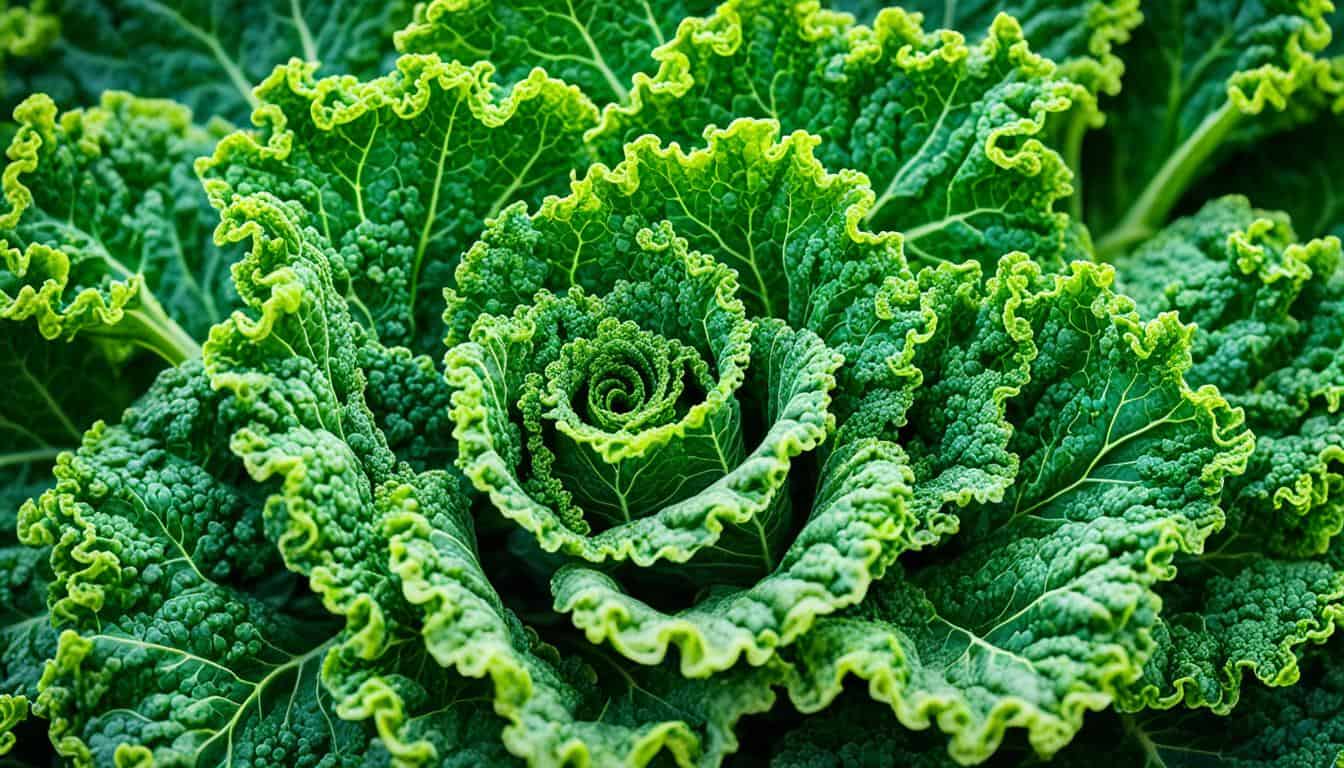
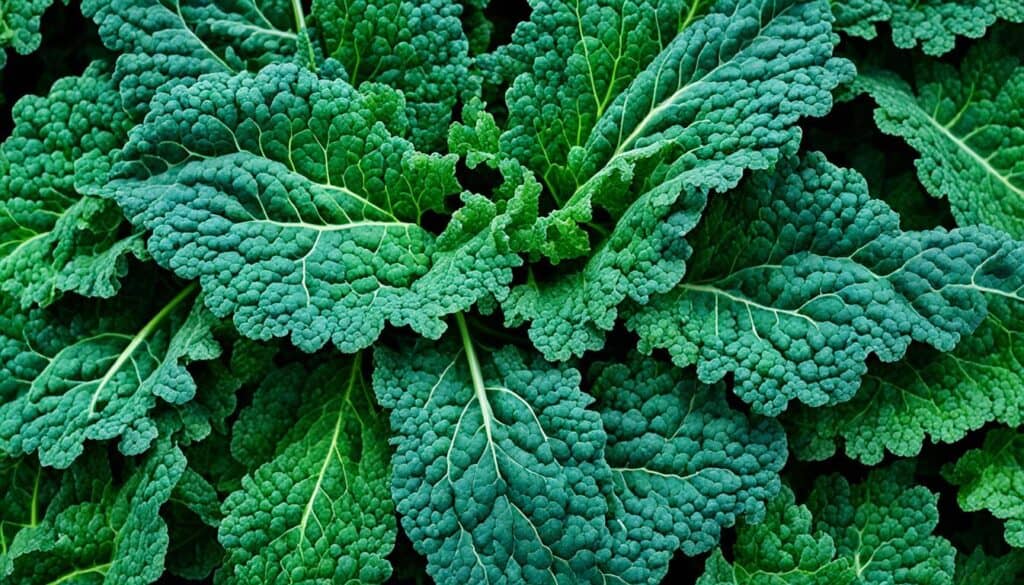
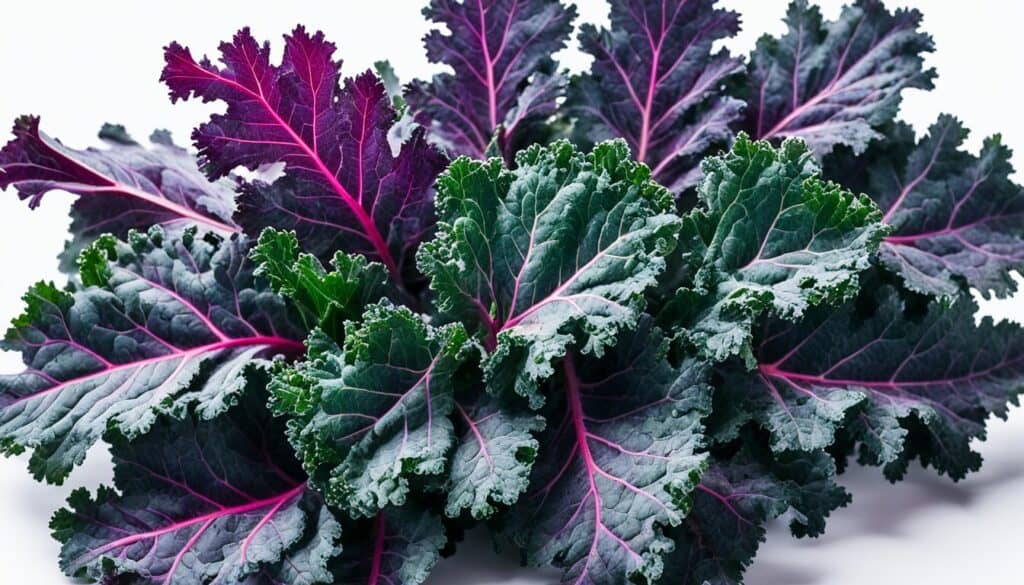
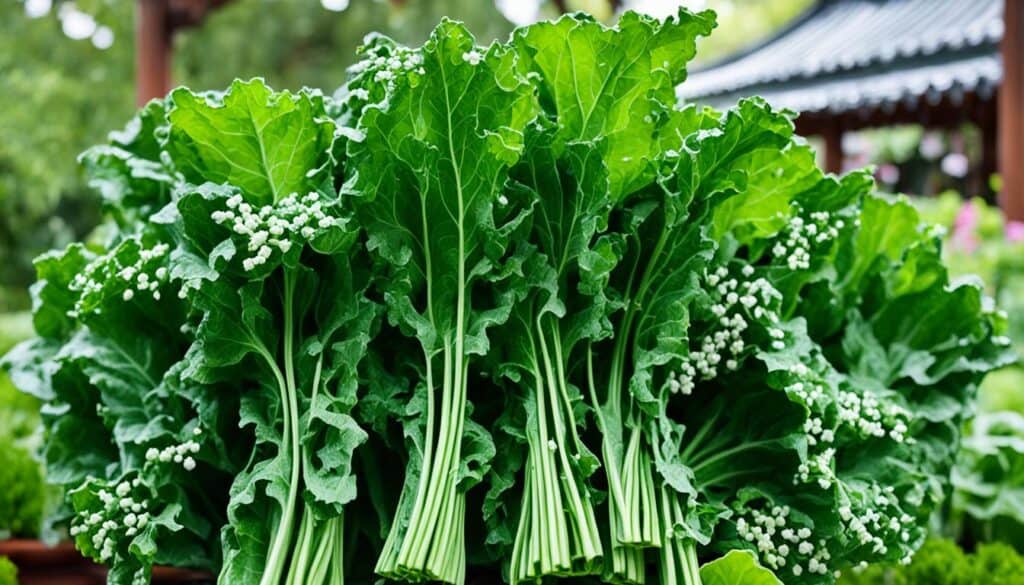
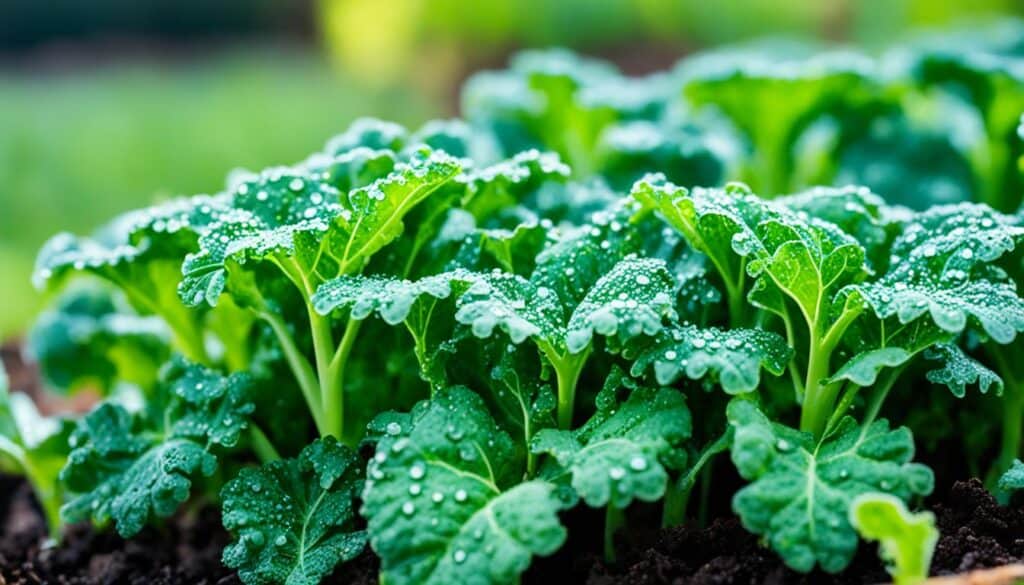




Leave a Reply